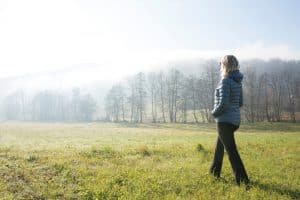Fitness and exercise are important health considerations for people over 50 – even in a lockdown. Here’s how to give the old joints a spring clean with exercise.

Walking is the only exercise in which the rate of participation does not decline in the middle and later years. Studies have found the highest percentage of regular walkers (39.4%) for any group was found among men 65 years of age and older.
In fact in early 2021, it is practically the only regular exercise you can take safely. The health clubs, gyms and golf club are all off
limits so now is the time to revisit walking to keep yourself mentally and physical healthy. Walking has been widely practiced as a recreational and fitness activity throughout recorded history. Classical and early English literature seems to have been written
largely by men who were prodigious walkers, and Emerson and Thoreau helped carry on the tradition in America.
Walking today is riding a wave of popularity that draws its strength from a rediscovery of walking’s utility, pleasures, and
health-giving qualities. This article is for those who want to join that movement.
Walking: The slower, surer way to fitness
People walk for many reasons: for pleasure … to rid themselves of tensions… to find solitude… or to get from one place to another. Nearly everyone who walks regularly does so at least in part because of a conviction that it is good exercise.
Often dismissed in the past as being “too easy” to be taken seriously, walking recently has gained new respect as a means of improving physical fitness. Studies show that, when done briskly on a regular. schedule, it can improve the body’s ability to consume oxygen during exertion, lower the resting heart rate, reduce blood pressure, and increase the efficiency of the heart and lungs. It also helps burn excess calories.
Since obesity and high blood pressure are among the leading risk factors for heart attack and stroke, walking often protection against two of our major killers.
Walking burns approximately the same amount of calories per mile as does running, a fact particularly appealing to those who find it difficult to sustain the jarring effects of long distance jogging. Brisk walking one mile in 15 minutes burns just about the same number of calories as jogging an equal distance in 81/2 minutes. In weight-bearing activities like walking, heavier individuals will burn more calories than lighter persons. For example, studies show that a 110-pound person burns about half as many calories as a 216-pound person walking at the same pace for the same distance.
Although increasing walking speed does not burn significantly more calories per mile, a more vigorous walking pace will produce more dramatic conditioning effects. When looking at the benefits to heart/lung endurance, how far one improves depends on his/her initial fitness level. Someone starting out in poor shape will benefit from a slow speed of walking whereby someone in better condition would need to walk faster and/or father to improve. Recent studies show that there are also residual benefits to vigorous exercise. For a period of time after a dynamic workout, one’s metabolism remains elevated above normal which results in additional calories burned.
In some weight-loss and conditioning studies, walking actually has proven to be more effective than running and other more highly-touted activities. That’s because it’s virtually injury-free and has the lowest dropout rate of any form of exercise.
Like other forms of exercise. walking appears to have a substantial psychological payoff. Beginning walkers almost invariably report that they feel better and sleep better, and that their mental outlook improves.
Walking also can exert a favourable influence on personal habits. For example, smokers who begin walking often cut down or quit. There are two reasons for this. One, it is difficult to exercise vigorously if you smoke, and two, better physical condition encourages a desire to improve other aspects of one’s life.
In addition to the qualities it has in common with other activities, walking has several unique advantages. Some of these are:
Almost everyone can do it
You don’t have to take lessons to learn how to walk. The only quality you need is to be motivated to step up your pace and distance and walk more often.
You can do it almost anywhere
All you have to do to find a place to walk is step outside your door. Almost any footpath, street, road, trail, park, field, or even a shopping mall will do. The variety of settings available is one of the things that makes walking such a practical and pleasurable activity.
You can do it almost anytime
You don’t have to partner with someone from your bubble, you can go on your own and set your own schedule. Weather doesn’t
pose the same problems and uncertainties that it does in many sports. Walking is not a seasonal activity. and you can do it in extreme temperatures that would rule out other activities.
It doesn’t cost anything
You don’t have to pay fees or join a private club to become a walker. The only equipment required is a sturdy, comfortable pair of shoes.
Walking for physical fitness
What makes a walk a workout? It’s largely a matter of pace and distance. When you’re walking for exercise, you don’t saunter, stroll, or shuffle. Instead, you move out at a steady clip that is brisk enough to make your heart beat faster and cause you to breathe more deeply.
Here are some tips to help you develop an efficient walking style:
Hold head erect and keep back straight and abdomen flat. Toes should point straight ahead and arms should swing loosely at sides.
Land on the heel of the foot and roll forward to drive off the ball of the foot. Walking only on the ball of the foot, or in a flat-footed
style, may cause fatigue and soreness. Take long, easy strides, but don’t strain for distance. When walking up or down hills, or at a very rapid pace, lean forward slightly. Breathe deeply (with mouth open, if that is more comfortable).
What to wear when walking
A good pair of shoes is the only “special equipment” required by the walker. Any shoes that are comfortable, provide good support, and don’t cause blisters or calluses will do, but here are some suggestions to help you make your selection:
Good running shoes (the training models with heavy soles) are good walking shoes, as are some of the lighter trail and hiking boots and casual shoes with heavy rubber or crepe rubber soles.
Whatever kind of shoe you select, it should have arch supports and should elevate the heel one-half to three-quarters of an inch above the sole of the foot.
Choose a shoe with uppers made of materials that “breathe,” such as leather or nylon mesh.
Weather will dictate the rest of your attire. As a general rule, you will want to wear lighter clothing than temperatures seem to indicate. Walking generates lots of body heat.
(Article source: 50 Connect)

